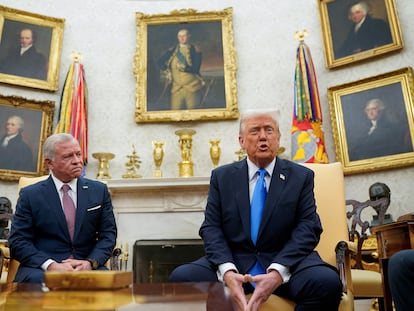US Supreme Court limits judges’ power to oppose Trump’s agenda
The ruling, which does not address the constitutionality of the order seeking to end birthright citizenship for the children of undocumented migrants, is a success for the Republican


The United States Supreme Court on Friday handed down a decision in the birthright citizenship case, perhaps the most important one of the judicial year, which concluded a frenetic day in which five other rulings were released as well. The nine justices did not address the constitutionality of President Donald Trump’s executive order, which he issued on his first day back in the Oval Office, aimed largely at ending automatic citizenship for children born on U.S. soil to undocumented migrants. And the justices did not do so because what the Trump administration was really seeking was for the justices to rule on nationwide injunctions —whether a decision by a federal judge in, say, Cheyenne, Wyoming contradicting an executive decision by a president should have effect on the entire country, as is currently the case, or only on the parties who filed the lawsuit.
The Supreme Court issued a 119-page decision (6-3) that was split along ideological lines: the six conservatives on one side; the three liberals on the other. The majority opinion is signed by Amy Coney Barrett, and states that when federal judges rule on an executive decision, they should apply that decision “as narrowly as possible.” It also calls on the high court to revisit the underlying case, on the issue of birthright citizenship.
It may seem like a purely procedural matter, but it is an enormously significant ruling, not only because it rebalances the relationship between the executive and judicial branches and changes the rules of the game in a procedural system that is often incomprehensible from a European perspective, but also because it paves the way for Trump to advance along the path of expanding presidential executive powers, ignoring the other two branches, legislative and judicial, as he has been doing in the five months since his return to the White House.
During that time, the Republican magnate has governed through executive orders and decrees, which in dozens of cases have been stopped by federal judges across the United States, where such positions are more politically charged than in other legal systems: federal judges are appointed by presidents, whether Democratic or Republican, and confirmed by the Senate. Following Friday’s Supreme Court ruling, when one of those federal judges orders a pause on an executive decision, it will not automatically prohibit its enforcement in all 50 states.
The current president is not the first to question that system. As the use of executive power has grown since the days of George W. Bush, so has the ability of federal judges to counter it, and the frustration of successive administrations, including those of Barack Obama and Joe Biden.
Trump signed the executive order that originated the case to repeal birthright citizenship, which is guaranteed by the Fourteenth Amendment, on his first day in the Oval Office, but three federal judges suspended the rule’s application with nationwideeffect.
Pushing the limits of power
The case has enormous implications given Trump’s tendency to push the limits of executive power with decisions whose main focus of resistance has been in the courts.
Trump decreed the end of birthright citizenship when the parents are undocumented immigrants or when the mother’s presence in the country is legal but temporary (such as someone with a student, work, or tourist visa) and the father is not a U.S. citizen or a legal permanent resident.
This decree runs counter to the interpretation of the law for more than a century following an amendment ratified in 1868, which states: “All persons born or naturalized in the United States . . . are citizens of the United States and of the State wherein they reside.” It was passed to end the Supreme Court’s interpretation that permanently excluded people of African descent from obtaining U.S. citizenship solely on the basis of race.
In a landmark 1898 ruling on an Asian immigrant, United States v. Wong Kim Ark, the Supreme Court broadly interpreted the Fourteenth Amendment, granting automatic citizenship to virtually all children born in the country. Since then, children of immigrants born in the United States have acquired citizenship regardless of their parents’ legal status.
What Trump intends to do, as part of his anti-immigrant agenda and xenophobic rhetoric, is to change this exception in the future, not retroactively. The U.S. president maintains that undocumented immigrants are not subject to U.S. jurisdiction and, therefore, are not entitled to birthright citizenship. Traditionally, the only excluded individuals have been the children of diplomatic personnel or, in a hypothetical scenario, the descendants of occupation forces on U.S. soil.
Sign up for our weekly newsletter to get more English-language news coverage from EL PAÍS USA Edition
Tu suscripción se está usando en otro dispositivo
¿Quieres añadir otro usuario a tu suscripción?
Si continúas leyendo en este dispositivo, no se podrá leer en el otro.
FlechaTu suscripción se está usando en otro dispositivo y solo puedes acceder a EL PAÍS desde un dispositivo a la vez.
Si quieres compartir tu cuenta, cambia tu suscripción a la modalidad Premium, así podrás añadir otro usuario. Cada uno accederá con su propia cuenta de email, lo que os permitirá personalizar vuestra experiencia en EL PAÍS.
¿Tienes una suscripción de empresa? Accede aquí para contratar más cuentas.
En el caso de no saber quién está usando tu cuenta, te recomendamos cambiar tu contraseña aquí.
Si decides continuar compartiendo tu cuenta, este mensaje se mostrará en tu dispositivo y en el de la otra persona que está usando tu cuenta de forma indefinida, afectando a tu experiencia de lectura. Puedes consultar aquí los términos y condiciones de la suscripción digital.
More information
Archived In
Últimas noticias
Aquilino Gonell, former Capitol sergeant: ‘If it hadn’t been for the police, the US would be a dictatorship’
A hybrid building: Soccer pitch, housing, and a shopping mall
Europe urges Trump to respect Greenland following annexation threats
Science seeks keys to human longevity in the genetic mixing of Brazilian supercentenarians
Most viewed
- Alain Aspect, Nobel laureate in physics: ‘Einstein was so smart that he would have had to recognize quantum entanglement’
- Mexico’s missing people crisis casts a shadow over World Cup venue
- Why oil has been at the center of Venezuela-US conflicts for decades
- Trump clarifies who is ultimately in charge in Venezuela: ‘Me’
- Mexico seeks to shore up its defenses following US incursion in Venezuela










































